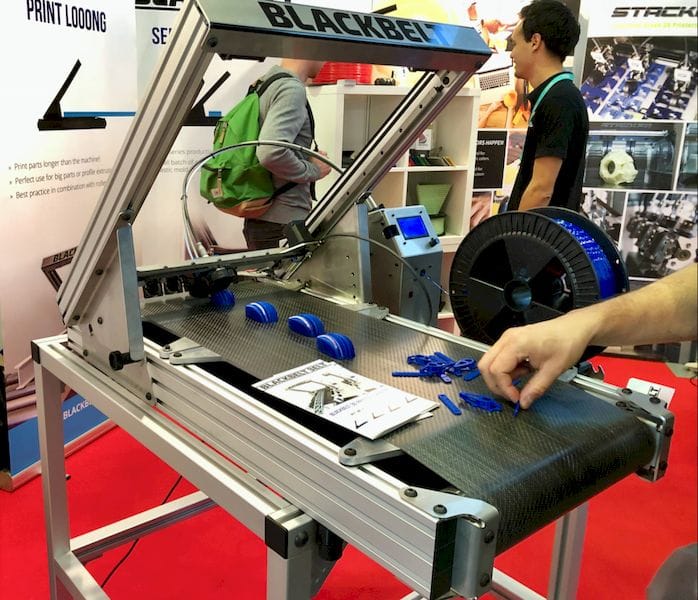![The BlackBelt continuous 3D printer provoked a response. [Source: Fabbaloo]](https://fabbaloo.com/wp-content/uploads/2020/05/image-asset_img_5eb0a15965d44.jpg)
We received a provocative comment about 3D printing and had to reply.
Instagram commenter Hanna Grzywnowicz, aka the 3DPrintingLady, commented on our recent post focusing on the BlackBelt continuous 3D printer. She writes:
”This machine has been around for a while now. Curiosity but rather pointless from practical point of view, despite the compelling story behind it – there is no interesting continuous real-time self-generating CAD file that would keep to the limitations of FDM, and why would a sturdy machine workshop keep printing continuous thermoplastic profiles that have no advantage over traditional manufacturing? Also, workshops don’t usually have patience to fiddle with FDMs, so it will remain a domain of makers and occasional users. FDM is not a serious industrial application, and never will be, despite companies trying to brand it as such.”
If you’re not familiar, the BlackBelt 3D printer is an unusual device that prints objects at an angle on a moving carbon fiber belt. This allows the machine to operate continuously because the belt simply rolls completed prints off the end into a bucket. It’s essentially a small factory that can crank out larger quantities of 3D prints without the need for significant human intervention.
Grzywnowicz suggests there is no need for such a style of device, as no one would need or want to 3D print large quantities of objects because they would have no advantage over traditional manufacturing, and that “FDM is not a serious industrial application”.
I’m not sure this is entirely true.
Traditionally manufactured objects have these general attributes:
-
Consistent part strength
-
Good surface quality
-
Wide choice of available materials
-
Cheap to produce in very large quantities
-
Expensive to produce in smaller quantities
-
Restricted part geometry due to manufacturing process limitations
-
All parts identical
Whereas (FDM) 3D printed options have these broad attributes:
-
Strong parts if properly designed and printed
-
Poorer surface quality
-
Restricted choice of available materials
-
Expensive to produce in very large quantities
-
Cheaper to produce in smaller quantities
-
Unlimited part geometry
-
All parts can be unique
These are clearly two different worlds of manufacturing, and each can answer different requirements.
For example, if you required a million identical parts, you would use traditional manufacturing because it was less expensive per part, regardless of almost any other factor.
If you required a specific material that is not available for 3D printing, you would choose traditional manufacturing.
On the other hand, if you required, say, a lightweight aircraft metal part with “impossible” geometry, then your only choice is 3D printing.
If you needed only 57 parts and not millions, then it would likely be less expensive to 3D print them in such low volumes. In fact several startup businesses are focusing on what’s called “low-volume manufacturing” for just this reason. And as time passes, the break-even point for 3D printing keeps rising as the technology improves.
3D printers are just another tool in the workshop, and like any tool, they should be used to solve certain kinds of problems. It’s just that today we don’t know all those problems! We’re still figuring that out!
It’s highly likely that a traditional workshop would indeed have no need for a continuously operating 3D printer, simply because they don’t have client types that match the characteristics above. Why don’t they? Because their current business uses equipment that prevents them from properly servicing those clients. It’s a chicken and egg situation. The problems being solved by those workshops are the “old” manufacturing problems, and they may not have encountered the need for “new” solutions yet.
The thing to remember here is that 3D printing is relatively new to the manufacturing scene, and explorations are still taking place. If we wanted to keep doing all the things we have always done, then fine, don’t try anything new.
But to achieve progress experiments must be made. Processes must be invented and deployed. They may fail, and often do. But some may survive and even thrive, like low-volume manufacturing.
This is one of the reasons we like to report on such devices: because these ideas need a chance to be used. They need a moment of everyone’s thoughts to consider whether they would be useful. They need the opportunity to test the business market. They need people to try them and see if they make sense.
That’s why ventures like BlackBelt exist: to see if there is a successful invention. To dismiss them – and the entire FDM market – is not the best strategy for our future.
Ten or twenty years from now we will look back and see the wreckage of dozens, hundreds of failed 3D printing ventures. But they were all necessary to find the solutions that worked.
Don’t dismiss new 3D printing processes; welcome them, and give them a good test.











No one seems to offer collaborative 3D printing modes on dual extrusion devices. We explain why this is the case.